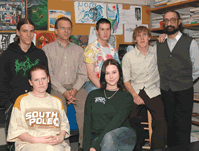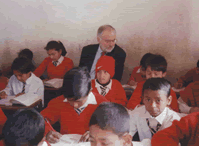|
EDUCATIONAL
POLICY & LEADERSHIP STUDIES
Alternative
Students Illustrate Success
 Bills (back row, second from left) and Elkadi (back row, far right) with student artists.
Bills (back row, second from left) and Elkadi (back row, far right) with student artists. |
Detractors
of alternative schools portray them as a last resort for students
unable or unwilling to apply themselves, a final layover on
the road to menial jobs, chronic unemployment, or worse.
But Hani Elkadi (Teaching Cert. '90/MA '97) knows
otherwise. Elkadi, lead art, health, and science teacher at
the Senior High Alternative Center in Iowa City, said many
of his students are bursting with creative energy and a passion
for learning.
He says they simply need people who believe in them, and
who back up their professed faith with action. People like
Associate Professor David Bills.
"For many, many years alternative education was ignored
or overlooked or denied as useful by many people who treated
these students as stereotypes," Elkadi said. "It just happened
that David Bills always believed in the fact that everybody
can learn. David has played a big role in our lives here."
Recently, Bills solicited artwork from Elkadi's art students
for his new textbook The Sociology of Education and Work,
which explores the links between schooling and the workplace
in modern society. The collaboration bore fruit in the form
of intriguing illustrations at the front of each of the book's
nine chapters.
"I described to the students what I wanted to accomplish
with each chapter and was stunned with the creativity and
insight with which they responded," said Bills, who has worked
with the school on several previous projects, including the
development of academic guidelines for the school.
Among the five students who contributed artwork to the book
was Megan Bishop, 17. For Chapter 8, "The Possibilities of
a Learning Society," one of three chapters that carry her
artwork, Megan drew what at first glance looks like a woman
walking along a path, past flowers and telephone lines. But
closer examination reveals that from the neck down the woman's
anatomy is visible, including organs, bone and muscle. And
what at first appear to be telephone poles and tree trunks
are in fact paint brushes and pencils, a white cloud rains
alphabet letters, musical notations glide along the Telephone
wires and a flower springing up from the earth has tiny scientific
notations and measurements.
Megan said being able to contribute her artwork to the textbook
was a great opportunity.
"With other books, you have the choice to read it or not,"
she said. "With a textbook, you have no choice. It's a definite
way to get people to look at my art. I loved the experience.
This was probably the best thing that has ever happened to
me."
Given such opportunities, Elkadi said, there's no telling
how far students like Megan might go. His former students
include illustrators for Disney movies, cartoonists, book
illustrators, sculptors, and other successful artists.
"The art becomes an exit for anger to happiness to joy,"
Elkadi said. "For a man of David Bills caliber to come to
us seeking artwork, it's a great honor." -by Stephan Pradarelli

Sagen
Named Fulbright Scholar
 As part of Sagen's Fulbright in Nepal, he visited a nearby private primary school.
As part of Sagen's Fulbright in Nepal, he visited a nearby private primary school. |
Although
Higher Education Professor Emeritus H. Bradley Sagen
retired six years ago, his work in the field has continued
to flourish. So far, his international consulting, research,
and teaching have taken him to 12 countries.
This summer, he received a Fulbright Senior Specialists grant
to work in Romania at the University of Bucharest. This is
Sagen's fourth Fulbright in 11 years-his third Fulbright and
fifth international project since retirement.
Sagen, who now lives in Ely, Minn., taught in the College
of Education for 34 years. Under the most recent Fulbright
grant, he will work with the University of Bucharest to provide
quality assurance to make sure the school's programs comply
with the European Agreement's standards for higher education.
Sagen said the country's goal is to meet the standards by
2005 so degrees granted in Romania will be accepted by universities
in other European Union-member countries.
Other trips abroad include teaching and conducting research
at Yonsei University in Korea, working with faculty members
at Tribhuvan University in Nepal on research methodology and
developing educational materials related to a master of education
in curriculum and evaluation, providing a higher education
sector assessment in Azerbaijan on behalf of the World Bank,
conducting training workshops for two universities on a project
at Sri Lanka, and Fulbright lectureship at Warsaw University
in Poland.
"I have become a firm believer in a comparative approach
to many issues now facing U.S. education," Sagen said. "Firsthand
experience is the only way to acquire any depth of comparative
understanding." -by Stephen Pradarelli
|